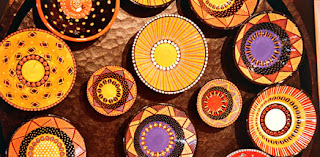Royal Art and kingship in Western Africa
“Just as the early Asante weavers unraveled European silk cloths to
obtain the yarn with which they wove the royal kente textiles. So quantities of
brass trade goods were imported from Europe to Benin from the sixteenth
century, where many were then melted down to provide raw material for the
already long-established tradition of making cast brass art in this powerful
West African kingdom. ”
There are many usages of bronze
in Africa. Ancient bronze objects were found in the river called Niger, but the
earliest tradition known when they used technology was in the ninth century.
The metals that were considered
precious were brass, gold and copper. They all are “golden” metals. These ore
were used to make royal regalia. The technique African people used was the wax
modeling, usually over a clay core which they covered with further layers of
clay.
“The whole was then fired, thus
melting the wax and allowing it to be drained off, leaving a hollow mould into
which molten metal was poured. The finished object could only be extracted by
breaking the clay- and is it therefore unique.”
Baga Nimba Mask 11,
Guinea
Coral regalia (shirt
and hat):

“Apart from brass, two other materials were closely associated with the
Oba: coral and ivory Coral is relates to the sea god Olokun, and legend relates
that the Oba’s coral regalia was taken from Olokun after an epic battle. Coral
therefore represents the Oba’s dominion over Olokun and Europeans who came
across the sea to Benin. ”
It’s really inspiring, using so
many “pearls” sewing together and making a wearable garment. I can imagine this
technology being used at a modern dress.
Head of Queen Mother
This head is outstanding for it's contraction and the cut of the hat. This head is a memorial to Queen Idia. People of Benin remembers her “the only woman who went to war”. In Benin art the head represents destiny and inborn hereditary powers.
Mask. Ivory,
brass and copper wire 16th century.
Helmet with horns
“Helmets with horns are associated with the office of sword-bearer. The
use of ram’s horns may refer to the proverb ‘a ram fights with its heart, not
its horns’, indicating the value placed on loyalty and commitment. The amulets
attached to the helmet refer to the power and strength of the ruler. For
instance, red seashells imported from the Canary Islands signify power over the
sea, its gods and those who sail across it: Europeans.”
Power of the hand! (Tools and arms)
“There was no Bronze
Age in sub-Saharan Africa, so the coming of iron technology must have had an
extraordinary impact on societies whose agricultural implements and weapons of
war had previously been made of stone and wood.”
The smith himself is perceived as having
magical power, which set him apart from the rest of the community. Iron bladed weapons inspired the colonial
authorities in Africa to start their production. African arms and armory were viewed by many, the material
and symbols of primitive savagery; it was durable, easily portable and involved
sings which represented the local tribe.
“The equation between
forged metal, power, leadership and personal achievement is still strong in
Africa.”
Shields
Shields were made for protection throughout history. The
decoration of shields were carried a very important aspect. In each army every
shield had a personal decoration which represented it's wielder and his
community.
South African Trivia, Phrases & Words
[REF]
Masai Shield and Spear
These are some templates which African people used for decorating shields:
A good idea and example of how you could use these shield forms and patterns in fashion design:
You can check out the whole history of swords and knifes here . I think it's really inspiring how they used the forms to make weapons out of it. I want to show you army costumes:
[REF]
Ceramic classics of Africa
The work of a potter is closely connected to the smiths and
is not coincidence that the husband of a potter was very often a smith. Potter
making in Africa was an exclusive female activity.
Many African societies believed that the potters created the natural
world and blacksmiths
the cultural world. Pottery is one of the oldest arts of Africa.
“The potting process of giving form to clay and its transformation
through fire has a primitive quality.”
Potting is also used as a general way of understanding the human change. The
process involves a series of rituals.
The most striking fact about African potting is the
simplicity of raw materials which required using a little earth, a few stones,
a corn and some firewood. The primary tool for this technique is the human hand. African
pots are cheap, versatile but functional. The technique of making pots is simple but
it got a formal beauty.
African ceramic bowl:
These artifacts made simple but the pattering is
significant, each color or symbol means something. I attached some photos which
I consider really inspiring. Just look at the coloring and forms.
[REF]
The most inspiring pattern which I saw at the whole documentation it was this amazing chemical plate. I can’t take my eye off this picture.
I hope you enjoyed it, hopefully is going to be a third part
with a little help from Telena Cassell(California) . Stay
tuned!


















No comments:
Post a Comment